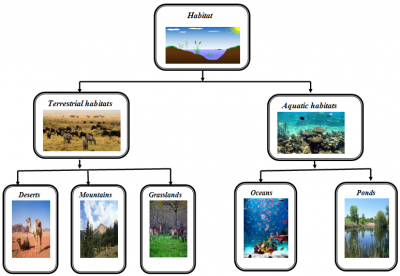
From baking hot deserts to snow capped mountains, the world is made up of many different habitats. Animals live in the habitat where they are best-suited to the temperature, weather, and food that is found there. Many different types of animal and plant live side by side in most habitats.
Mountain
The snowy peaks and lower slopes of cold mountains are home to a few tough animals. Any land that measures more than 600 m (2,000 ft) in height is called a mountain.
Some mountains form when the big slabs of rock—called tectonic plates—that make up the Earth’s crust crash into each other. Over millions of years, the sheets of rock push up and over one another, creating the mountain. Others form when vents in the Earth’s surface erupt and spew lava out onto the ground. The lava piles up and cools. Over millions of years, the many layers of hard lava become a mountain.
Forest
Forests are essential for life on earth. Three hundred million people worldwide live in forests and 1.6 billion depend on them for their livelihoods. Forests also provide habitat for a vast array of plants and animals, many of which are still undiscovered. They protect our watersheds. They inspire wonder and provide places for recreation. They supply the oxygen we need to survive. They provide the timber for products we use every day.
More animals live in forests than any other habitat on land. The three main forest types are steamy rainforests, cooler temperate rainforests, and cold coniferous forests.
Grassland
Grassland habitats can be found in many places around the world, and in a variety of climates. They are sometimes called other names, such as prairies, savannahs, steppes or pampas, depending on where in the world they are and the sort of climate there. Animals have adapted to the fact that grasslands don’t have many places to hide from predators by making homes in the ground, or by being tall enough to see over high grasses and shrubs.
Hot grasslands that have a rainy season and a dry season are called tropical grasslands. Temperate grasslands have some rain all year, and both hot and cold seasons.
Desert
One of the world’s most difficult habitats to live in the desert, because less than 25 cm (10 in) of rain falls in a year. Temperatures are high in the day and very cold at night. Some deserts are always cold—in fact the biggest desert in the world is Antarctica! Even though it’s covered in snow and ice, it rarely rains or snows in Antarctica, which makes it a desert. Desert animals also have adaptations that help them survive without much water. Kangaroo rats in the Sonoran Desert get water from the seeds they eat. Some carnivores, such as desert foxes, get enough liquid from their prey.
Polar
Polar habitats cover the top and bottom of planet Earth at the North and South Poles. The North Pole is surrounded by the Arctic Ocean. There isn’t any land here, just a group of continually shifting ice sheets. Parts of Canada and Greenland are near the North Pole. The South Pole is located on Antarctica. This area has land, but it’s completely covered with a layer of ice that’s almost three miles thick in some places.
The polar regions of the Arctic and Antarctic are frozen worlds of floating ice caps and howling winds. These extreme places are empty lands with few plants or animals.
Ocean
Oceans are areas of salty water that fill enormous basins on the Earth’s surface. Even though Earth has one continuous body of saltwater, scientists and geographers divide it into five different sections. From biggest to smallest, they are the Pacific, the Atlantic, the Indian, the Antarctic (sometimes called the Southern), and the Arctic Oceans.
Oceans are deep as well as wide. On average an ocean is a little over two miles deep. But about 200 miles southwest of Guam in the Pacific Ocean, the water in the Mariana Trench is almost seven miles deep. That’s the deepest part of the ocean.
The world’s oceans make up two-thirds of our planet’s surface. Scientists think that this huge habitat is home to millions of different types of animal that have yet to be discovered.
Microhabitats
A microhabitat is a habitat on a miniature scale. It can be as tiny as the space under a stone. The smallest difference in temperature or the amount of moisture will make a microhabitat more attractive to one type of animal than another. A seaside rock pool is an example of a microhabitat and is home to lots of living things.
Picture Credit : Google



